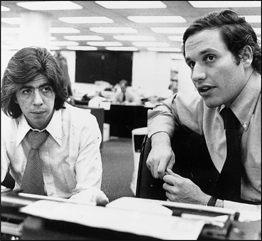
Daniel Ellsberg worked for the government as an intelligence analyst for the Defense Department in the mid-1960s. He assisted in compiling the 1967 classified study of U.S. efforts in Vietnam. Every aspect of the war was studied in detail, beginning with the origins of the conflict in 1940 and ending with the escalating war. Ultimately the study totaled more than seven thousand pages.

Washington Post reporters Carl Bernstein (left) and Robert Woodward (right), who had reported the Watergate scandal.
Ellsberg found that the government had misled its citizens about a war many of its own experts felt could not be won. In 1969 he began copying parts of the study. His next step was very difficult. The publicizing of classified government documents is a serious offense. Because the papers he now had dealt with national security issues, Ellsberg could be tried for violating the Espionage Act. But Ellsberg felt that it was worth risking the threat of imprisonment to tell the full truth about the U.S. efforts in Vietnam.
In 1971 he gave his documents to the New York Times. The first of these documents, which came to be known as the “Pentagon Papers,” were published on June 13, 1971. President Nixon was furious when he discovered what had happened. He tried to get the publication of these documents stopped, but the Supreme Court overruled him.
The White House authorized the use of illegal wiretaps of Ellsberg’s phone and the burglary of his psychiatrist’s office. Ellsberg was arrested and brought to trial, which was declared a mistrial. The second trial was dismissed by the judge when President Nixon’s abuse of power regarding Ellsberg became public.
But Nixon’s abuses of power extended far beyond Daniel Ellsberg. They also included illegal wiretaps of reporters’ telephones, spying on White House staffers, and the attempted burglary of the offices of the Democratic National Committee in the Watergate Hotel by a specially trained team of men. Nixon wanted to obtain information about the Democratic presidential campaign plans.
The series of abuses of power and the following cover-up attempts came to be known as the “Watergate scandal,” named after the hotel where police had captured the burglars. The scandal would result in a chain of hearings and trials that led to calls for impeachment of the president. Nixon avoided impeachment by resigning from office on August 9, 1974.